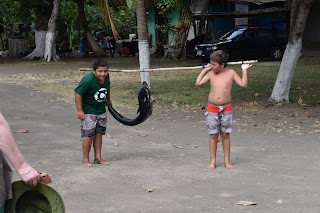Three unexpected beaches; Jacó, Tarcoles & Gaucalillo
It actually took us a while to get to the beach and our first few beach experiences weren’t really what I’d been envisioning (we WILL get there eventually though!).
BEACH #1 - PLAYA JACÓ
Boy was it HOT. We got to Jacó as it was getting dark and had a wander around. We knew that it wasn't really our street - it’s a touristy party town* with groups of middle-aged gringos stumbling around and shouting at each other. It was a real departure from the rural vegan eco-farm that we were living on. We went to the beach but of course it was dark and we were a bit scared of everything as it was still early days in the tropics.
Our plan was to go to the beach the next day before we continued our journey, but after spending some time at the pool in the morning, by 10am I was slathered in sun cream, head to toe in white, hat on and it was just too blinding hot to be outside. It was painfully hot. So we didn’t go to the beach. I’ve seen the pictures and it looks nice. It’s also very popular as it’s not hard to reach from San José, the capital where the main airport is. We’ll just have to see if we make it back there!
*it’s still tiny though - the nearest I can think it’s like it 1980s Tenerife, but probably smaller with less development. I’ve just looked it up and 10,000 people live there. The biggest city here has 335,000 people, not that much bigger than Doncaster. The big city we lived near in the south - San Isidro - has about 50k inhabitants - the same kind of size as Salisbury. (The “big town” where we live now - San Vito - has a population of 5,500!).
BEACH #2 - PLAYA TARCOLES
So the next day we decided to check out Tarcoles (pronounced Taa-cole-S) beach and go for lunch there. This is what we found…
Basically, don’t be swimming here folks! It was very beautiful in a wild/sea-bird kind of way and personally I love the sign that says “Crocodiles in their natural environment”. One of things Costa Rica has really brought into sharp relief for me is how this planet belongs to all of us - people, animals and plants, it is all of our home. Those crocodiles have at least as much right to be hanging out on that beach as we do.
So we looked for somewhere to have lunch. The equivalent of a corner caff here is called a “soda”. It usually serves a fixed menu of a casada - a meal of rice, beans and meat, often accompanied by fried plantain and a small salad and with a chilli sauce or pickles on the side. To drink you will be able to have a batido (milk smoothie) or refresco (milk or water smoothie). I say smoothie but interestingly they rarely put bananas in smoothies, though they are almost literally 10 a penny here, much more often you get papaya, pineapple, passion-fruit, mango, blackberry, strawberry (if you’re high up), lemon, guava etc. The meals and drinks here are around £3/4, though we have had very basic ones for a couple of pounds equivalent. The main alternative to this kind of meal is fried chicken/burgers and fizzy drinks. Those meals are often a bit more expensive.
The soda we stopped at, called Las Lapas - referring to the scarlet macaws you get on the coast - belonged to a family who didn’t look too well off. There were some women sitting outside breastfeeding children. Another lady was inside in the corner with a cot/playpen and a baby. She said that she used to live in Nicaragua and it was much cheaper there but it wasn’t safe.
It is a difficult choice for lots of people here - whether to choose a cheaper lifestyle or security. It's pretty impossible for us to really understand what that's like. It makes "standard of living" a different type of conversation.
This was the first time I saw what has become one of my favourite joyful things about Costa Rica - one of those “hooks” that could keep me (us) here for longer and longer - brown pelicans flying over the beach in a scoop*, touching or landing on the water. Often from the beach they look like surfers in the distance. Or sometimes when you’re sunbathing on the beach or you suddenly see them overhead through the palm trees or as you float on your back looking up at the sky. At the right time of day, as you're walking on the beach looking for flotsam and jetsam, they'll come to your attention when you see their shadows on the ground flickering past. They are - and I use this word infrequently - awesome. They feel me with indescribable joy and always remind me how incredibly lucky we are to be here in this beautiful place.
*The interweb tells me pelicans have many collective nouns, including a "brief", "pod", "pouch", "scoop", and "squadron" of pelicans. There's a kids' book in there peeps!
We did see crocodiles at the bridge in Tarcoles though. And some grackles (which are a kind of pretty tailed crow that you see a lot here) and a pair of kingfishers.
BEACH #3 - PLAYA GUACALILLO
I think it’s worth re-stating here that we had still only been in Costa Rica for a couple of weeks at this point and we hadn’t acclimatised (now we think it’s chilly if it drops below 20 degrees!). It is extremely warm and humid on the coast, which we also weren’t used to having been in the mountains and on the central plateau up to this point. It was also the middle of summer and so the hottest and driest time of the year. So anywhere we saw at this time of year *might* be green and lush in the wet season (or it might not be!).
So we were headed up to Playa Guacalillo (pronounced Gua-ca like mole and lee-yo) from Dominical along the coast road. The landscape here was completely different from the hilly coffee area and natural rain forest we were used to. The (dead straight) coast road has a *lot* of mono-cultural palm plantations, punctuated by worker towns - two storey clapboard houses cut out of the plantations and set around a football field at the side of the road. We were headed to meet Lola - a young pup who was going to need looking after whilst her French Canadian owners went off on holiday. That visit is probably for a different post.
We went for a walk along the beach as the sun was going down. It was beautiful but barren and wild. Almost post-apocalyptic. There was a lagoon where crocodiles live and which joins up with the sea in the green/wet season.
There were very fast tiny crabs and the sand was black - I think volcanic rocks. Iris got filthy. I think I did too. And there were lots of bitey things - sand flies, no see-ums, mosquitoes. It was...unexpected.






















Comments
Post a Comment